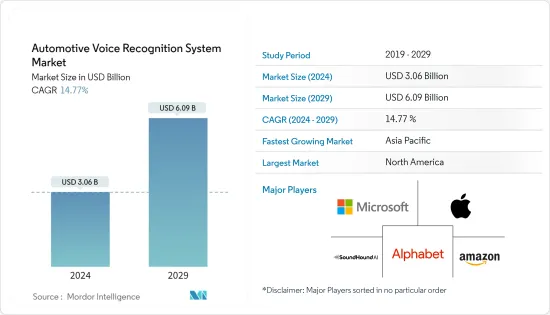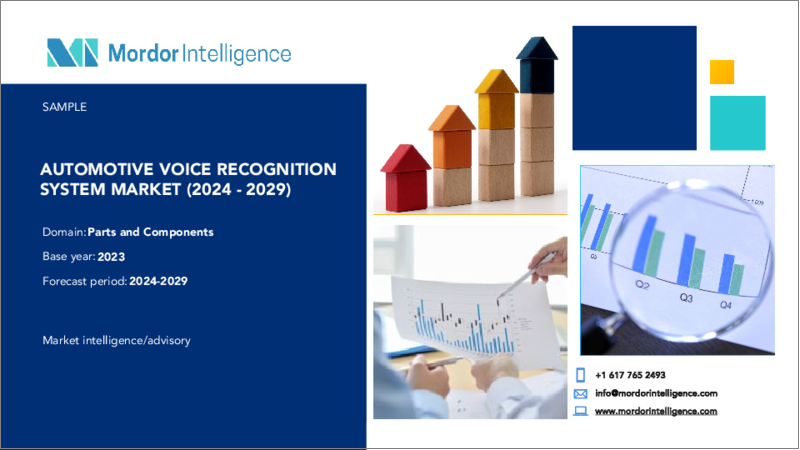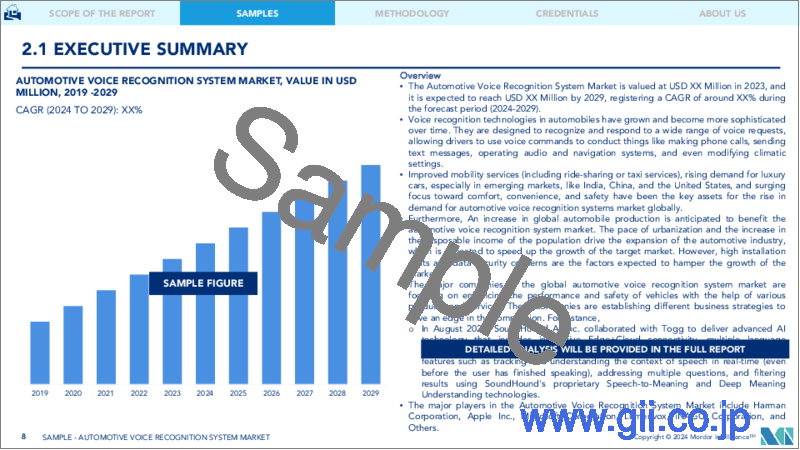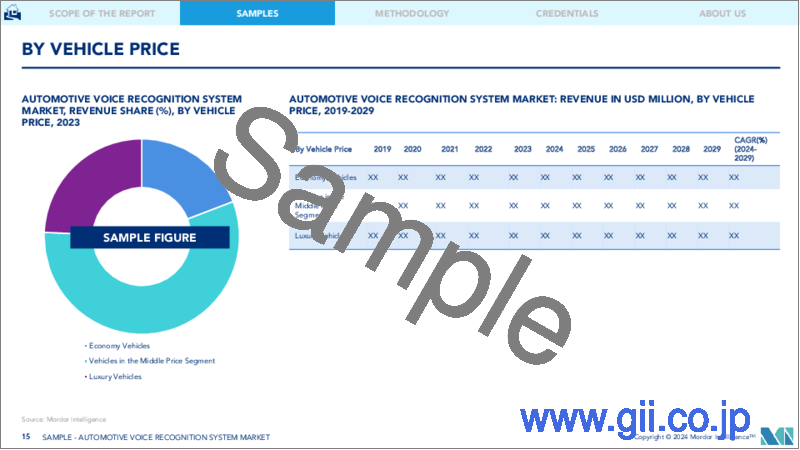|
|
市場調査レポート
商品コード
1537616
自動車用音声認識システム:市場シェア分析、産業動向・統計、成長予測(2024~2029年)Automotive Voice Recognition System - Market Share Analysis, Industry Trends & Statistics, Growth Forecasts (2024 - 2029) |
||||||
カスタマイズ可能
適宜更新あり
|
|||||||
| 自動車用音声認識システム:市場シェア分析、産業動向・統計、成長予測(2024~2029年) |
|
出版日: 2024年08月14日
発行: Mordor Intelligence
ページ情報: 英文 100 Pages
納期: 2~3営業日
|
全表示
- 概要
- 目次
世界の自動車用音声認識システムの市場規模は、2024年に30億6,000万米ドルに達し、2024~2029年の予測期間中にCAGR 14.77%で成長し、2029年には60億9,000万米ドルに達すると予測されています。

市場促進要因としては、自動車生産・販売台数の増加、世界の大半の地域で消費者の所得水準が上昇し、快適で贅沢なサービスに多くの支出を行えるようになったこと、ドライバーに安全性と快適性を提供するインフォテインメントやテクノロジーサービスの開拓、最新のコネクティビティやAI機能を搭載した自動車に対する若年層の嗜好の高まりなどが挙げられます。
*国際自動車工業会(OICA)によると、小型商用車の新車販売台数は2021年の1,860万台に対し、2022年には1,980万台に達し、前年比7%の大幅な伸びを記録しました。
さらに、自律走行車とコネクテッドビークル技術の急速な強化は、ADAS(先進運転支援システム)が 促進要因にハンズフリー体験を提供することを支援するため、ADAS(先進運転支援システム)の需要に拍車をかけると思われます。さらに、世界の電気自動車の普及拡大も、自動車用音声認識システムの需要拡大に大きく寄与しています。
*国際エネルギー機関(IEA)によると、世界のバッテリー式電気自動車の販売台数は、2021年の460万台に対し、2022年には730万台に達し、前年比58.6%の成長を示しています。
同市場の主要企業は、大手自動車メーカー(OEM)と提携し、音声認識技術をOEMの車両に組み込むことでサービスを拡大しています。
*2023年8月、SoundHound AI Inc.は、革新的なEdge+Cloud接続、多言語機能、カスタムブランドの音声アシスタントを含む高度なAI技術を発表し、トルコのモビリティプロバイダーであるTogg社のスマートカーの新ラインに統合しました。さらに同社は、Toggの車載AI搭載音声アシスタントは、リアルタイムで(場合によってはユーザーが話し終える前でも)音声の文脈を追跡・理解できると述べています。SoundHound独自のSpeech-to-Meaning(R)およびDeep Meaning Understanding(R)技術を使用することで、複数の質問に対応し、結果をフィルタリングすることもできます。
*2022年9月、BMW Groupは、BMWインテリジェントパーソナルアシスタント(IPA)の最新バージョンに統合するための新しい音声およびAI搭載音声アシスタントの開発に、Microsoft Corp.の子会社であるCerence Inc.を選定したと発表しました。これらの機能は新型BMW 7 SeriesとBMW i7に搭載されます。
アジア太平洋は、コネクテッドカーの販売台数が多いこと、若い自動車購入者が音声認識技術のような最新のコネクテッド機能を選択する意欲があること、自動車メーカーの存在感が大きいことなどから、最も急成長する地域市場になると予想されます。欧州と北米は、音声認識のような新時代の技術と自動車購入者の親和性が高く、コネクテッドカーの販売台数が多いことから、次いで大きな市場となっています。
自動車用音声認識システムの市場動向
予測期間中、乗用車セグメントが牽引役となる
顧客は、パワーやトルクの数値よりも運転の快適性や利便性を求めるため、自動車の機械的仕様よりも高度なコネクティビティ機能を備えた自動車の購入を好むようになっています。この動向は世界の主要自動車市場でますます見られるようになっており、車載音声認識システムのような機能に対する需要が増加しています。
- 国際自動車工業会(OICA)によると、世界の新車乗用車販売台数は2021年の5,640万台に対し、2022年には5,740万台に達し、前年比成長率は1.9%となりました。
さらに、音声認識システムの需要は、コネクテッドカーと自律走行車の販売台数の増加によって加速しています。コネクテッドカーだけでなく、自律走行車も音声認識技術を標準装備しています。音声認識システムは、 促進要因を基本的な定型作業から解放し、運転に完全に集中できるようにするため、自動車事故の件数を減らすと見られています。Mercedes、BMW、Audiなど、さまざまな自動車メーカーが提供する高級車やプレミアム乗用車は、産業での競合優位性を獲得するために、先進的な音声認識システムを急速に車両に組み込んでおり、これが市場のこのセグメントの需要急増にプラスの影響を与えています。
- 2022年には、BMW、Mercedes-Benz、Audiが高級車の世界販売台数が最も多い主要自動車メーカーとなりました。2022年の高級車販売台数は、BMWが240万台、Mercedes-Benzが207万台、Audiが161万台です。
このように、コネクテッドカーや自律走行車の販売動向の増加、自動車の安全性向上の傾向、ファミリーセダンやコンパクトSUVのような中価格帯の自動車に音声認識システムが搭載されていることなどは、予測期間中に市場を牽引すると予想される要因の一部です。
予測期間中、アジア太平洋が最も急成長する見込み
アジア太平洋は、北米、欧州に次いで急成長が見込まれる地域市場です。アジア太平洋は乗用車の巨大市場です。インドと中国は世界最大級の乗用車市場であり、世界の乗用車販売台数の30%近くを占めているため、アジア太平洋は自動車用音声認識システムにとって最も有利な地域市場となっています。
- 電気自動車工業会によると、電動四輪車の販売台数は2022年度の1万9,782台に対し、2023年度は4万8,105台に達し、前年比143.1%の伸びを示しました。
- 日本自動車販売協会連合会によると、2023年10月の日本の新車市場は力強い回復を見せ、販売台数は2022年10月の35万9,159台から10.7%増の39万7,672台となりました。
アジア太平洋諸国の大手自動車メーカーは、顧客の利便性を高めるため、先進的なソリューションを自動車に組み込むことをますます好むようになっています。人工知能やバーチャルアシスタント対応の音声認識システムを車両に組み込むことは、これらのプレーヤーが頼りにしている革新的な技術的特徴のひとつです。大手自動車メーカーは音声認識システム・サプライヤーと長期的なパートナーシップを結び、需要の増加に対応できる高度な音声認識システムの開発に多額の投資を行っています。
- Renault Korea Motorsは2023年11月、Tmap Mobility Co.と将来のインフォテインメント協力に関する覚書を締結したと発表しました。ルノー韓国は、新車開発プロジェクト「Aurora Project」の一環として、中型ハイブリッドスポーツ多目的車(SUV)に車載音声認識「NUGUオート」、Tmap Store、車載簡単決済、電気自動車に特化したサービスを提供できる「Tmap Infotainment」を搭載する計画です。
- Cerence Inc.は2023年4月、中国のスマートカーサプライヤーであるBanma社が、Shanghai Volkswagen Automotive Co. (SVW)やFAW-Volkswagen (FAW-VW)を含むBanmaの自動車メーカー顧客に先進的な車載会話AIと音声認識技術を提供するためにCerenceを採用したと発表しました。Cerenceの主力製品である会話型AIは、車載アシスタントがプロアクティブで信頼できる副操縦士として機能し、安全、情報、快適性を維持しながらドライバーの日々の旅に導くことを可能にします。
このように、この分野における急速な進歩と革新により、自動車用音声認識システムの市場は、アジア太平洋諸国の商用車と乗用車の両セグメントで予測期間中に成長すると予想されます。
自動車用音声認識システム産業の概要
自動車用音声認識システム市場は、さまざまな既存プレーヤーと新規参入プレーヤーがエコシステムで事業を展開しているため、断片化されており、競争が激しいです。同市場は、大手自動車メーカーと提携を結んだかなり大規模なプレーヤーの存在によって特徴付けられます。これらのプレーヤーはまた、ブランドポートフォリオを拡大し、市場での地位を固めるために、合弁事業、合併・買収、新製品の発売、製品開拓を行っています。例えば、
- 2024年1月、Volkswagenは、2024年春から、VW 1D3、ID4、ID5、ID7、Tiguan、Passat、Golfのインフォテインメントの一部であるCerence Chat ProシステムがChatGPTを統合し、音声リクエストの解析を支援し、様々な機能を可能にすると発表しました。これには、インフォテインメント、ナビゲーション、空調機能の制御が含まれます。
- 2023年6月、英国の自動車メーカーMorris Garagesのインド部門であるMG Motor Indiaは、Jio Platformsとの提携を発表し、インドで新たに発売するスマート電気自動車にコネクテッドカー機能の一部として独自の音声ソリューションを提供することを明らかにしました。契約に基づき、Jioのヒングリッシュ音声アシスタントシステム「HelloJio」は、コメットEVを運転するインドのユーザーに多目的な車載音声アシスタントを提供します。
- LG Electronics Inc.は2022年7月、SoundHound AI Inc.と提携し、SoundHoundの高度なAIベースの音声認識プラットフォームをLGの自動車向けIVIインフォテインメント・システムに組み込みました。この提携により、LG Electronics Inc.はSoundHound Inc.の高度な音声ベースのAIを提供することが可能になり、会話型の音声コントロールを提供することで、自動車の運転手と同乗者の非常に高い利便性を確保することができます。
同市場では今後数年間、自動車の音声認識システムに人工知能やAlexaのようなバーチャルアシスタントなどの先進技術が統合されることが予想されます。
その他の特典:
- エクセル形式の市場予測(ME)シート
- 3ヶ月間のアナリストサポート
目次
第1章 イントロダクション
- 調査の前提条件
- 調査範囲
第2章 調査手法
第3章 エグゼクティブサマリー
第4章 市場力学
- 市場促進要因
- 高級乗用車とプレミアム乗用車の需要増加が市場成長を促進
- 市場抑制要因
- 高い購入・設置コストが市場成長の阻害要因
- 産業の魅力 - ポーターのファイブフォース分析
- 新規参入業者の脅威
- 買い手/消費者の交渉力
- 供給企業の交渉力
- 代替品の脅威
- 競争企業間の敵対関係の強さ
第5章 市場セグメンテーション(市場規模:米ドル)
- 自動車タイプ別
- 乗用車
- 商用車
- 技術別
- 組み込み型
- クラウドベース
- ハイブリッド
- 車両クラス別
- エコノミー
- 中価格帯
- ラグジュアリー
- 地域別
- 北米
- 米国
- カナダ
- その他の北米
- 欧州
- ドイツ
- 英国
- フランス
- イタリア
- その他の欧州
- アジア太平洋
- 中国
- インド
- 日本
- 韓国
- その他のアジア太平洋
- その他の地域
- 南米
- 中東・アフリカ
- 北米
第6章 競合情勢
- ベンダー市場シェア
- 企業プロファイル
- Microsoft Corporation
- Apple Inc.
- Alphabet Inc.
- Harman International Industries
- Nuance Communications Inc.
- Sensory Inc.
- IBM Corporation
- SoundHound AI Inc.
- Kardome Technology Ltd
- Amazon.com Inc.
- Robert Bosch GmbH
- iNago Corporation
第7章 市場機会と今後の動向
- 人工知能(AI)やバーチャルアシスタントなどの先端技術の音声認識システムへの統合が市場需要を促進
The Automotive Voice Recognition System Market size is estimated at USD 3.06 billion in 2024, and is expected to reach USD 6.09 billion by 2029, growing at a CAGR of 14.77% during the forecast period (2024-2029).

Over the forecast period, the market is expected to be driven by several factors, including increasing automobile production and sales, higher income levels of consumers in most parts of the world, enabling them to spend more on comfort and luxury services, development of infotainment and technology services to provide safety and comfort to the driver as well as the growing preference of young customers for automobiles equipped with the latest connectivity and AI features.
* According to the International Organization of Motor Vehicle Manufacturers (OICA), new light commercial vehicle sales touched 19.8 million units in 2022 compared to 18.6 million units in 2021 worldwide, recording a substantial Y-o-Y growth of 7%.
Moreover, rapid enhancement in autonomous vehicles and connected vehicle technology will fuel the demand for advanced automotive voice recognition systems as they assist in providing a hands-free experience to drivers. Coupled with that, the increasing penetration of electric vehicles worldwide is also a major contributor to the rising demand for automotive voice recognition systems.
* According to the International Energy Agency (IEA), battery electric vehicle sales worldwide touched 7.3 million units in 2022 compared to 4.6 million units in 2021, representing a Y-o-Y growth of 58.6%.
Key players in the market are expanding their services by tying up with major automobile original equipment manufacturers (OEMs) to integrate their voice recognition technologies into OEMs' vehicles. For instance,
* In August 2023, SoundHound AI Inc. launched its advanced AI technology, including innovative Edge+Cloud connectivity, multiple language capabilities, and a custom-branded voice assistant to be integrated into a new line of smart vehicles from Turkish mobility provider Togg. Further, the company stated that Togg's in-vehicle AI-powered voice assistant can track and understand speech context in real-time (in instances even before the user has finished speaking). Using SoundHound's proprietary Speech-to-Meaning(R) and Deep Meaning Understanding(R) technologies, it can also address multiple questions and filter results.
* In September 2022, BMW Group announced that it had selected Cerence Inc., a Microsoft Corp. subsidiary, for developing a new voice and AI-powered voice assistant for integration into the latest version of BMW Intelligent Personal Assistant (IPA). These features would be available in the new BMW 7 Series and BMW i7.
Asia-Pacific is expected to become the fastest-growing regional market due to large sales of connected vehicles, young automobile buyers' willingness to opt for the latest connectivity features like voice recognition technology, and a large presence of automakers. Europe and North America are the next largest markets because of the close affinity of car buyers to new-age technologies like voice recognition and high sales of connected vehicles.
Automotive Voice Recognition System Market Trends
Passenger Cars Segment to Gain Traction During the Forecast Period
Customers increasingly prefer to purchase a car with advanced connectivity features rather than the mechanical specifications of the vehicle because they demand driving comfort and convenience more than the outright power or torque figures. This trend is increasingly observed in major automotive markets worldwide, which has led to an increase in the demand for features like in-vehicle voice recognition systems.
- According to the International Organization of Motor Vehicle Manufacturers (OICA), new passenger vehicle sales worldwide touched 57.4 million units in 2022 compared to 56.4 million units in 2021, representing a Y-o-Y growth of 1.9%.
Further, the demand for voice recognition systems is being accelerated by the rising sales of connected cars and autonomous vehicles. Both connected as well as autonomous vehicles have voice recognition technology as a standard feature. Voice recognition systems have been seen to reduce the number of vehicle accidents since they free drivers from basic, routine tasks so they can fully concentrate on driving. Luxury and premium passenger cars offered by various automakers, such as Mercedes, BMW, and Audi, are rapidly integrating advanced voice recognition systems in their vehicles to gain a competitive edge in the industry, which, in turn, is positively impacting the surging demand for this segment of the market.
- In 2022, BMW, Mercedes-Benz, and Audi were the leading automakers with the highest luxury vehicle sales worldwide. BMW registered sales of 2.4 million units of luxury vehicles, followed by 2.07 million units by Mercedes-Benz and a sales volume of 1.61 million units by Audi in 2022.
Thus, increasing sales of connected and autonomous vehicles, the trend toward greater vehicle safety, and the availability of voice recognition systems in mid-priced vehicles like family sedans and compact SUVs are some of the factors anticipated to drive the market in the forecast period.
Asia-Pacific Expected to be the Fastest-growing Regional Market During the Forecast Period
The Asia-Pacific is expected to be the fastest-growing regional market, followed by North America and Europe. Asia-Pacific is a huge market for passenger vehicles. India and China are some of the largest markets for passenger vehicles in the world, contributing to almost 30% of the global passenger vehicle sales, thus making Asia-Pacific the most lucrative regional market for automotive voice recognition systems.
- According to the Society of Manufacturers of Electric Vehicles, electric four-wheeler sales touched 48,105 units in FY 2023 compared to 19,782 units in FY 2022, representing a Y-o-Y growth of 143.1%.
- According to the Japan Automobile Dealers Association, in October 2023, the new vehicle market in Japan made a strong recovery, with sales rising by 10.7% to 397,672 units from 359,159 units in October 2022.
Major auto manufacturers in Asia-Pacific countries are increasingly preferring to integrate advanced solutions in their vehicles to enhance customers' convenience. The incorporation of artificial intelligence and virtual assistant-enabled voice recognition systems in their vehicle fleets is among the innovative technological features that these players are relying on. Major automakers are forming long-term partnerships with voice recognition system suppliers and are investing hefty sums in the development of advanced voice recognition systems that can cater to the increasing demand. For instance,
- In November 2023, Renault Korea Motors announced that it had signed a memorandum of understanding (MOU) with Tmap Mobility Co. for future infotainment collaboration. As part of the new car development project "Aurora Project," Renault Korea plans to equip the mid-size hybrid sports utility vehicle (SUV) with "Tmap Infotainment," which is capable of providing in-car voice recognition "NUGU Auto," Tmap Store, in-car easy payment, and electric vehicle-specialized services.
- In April 2023, Cerence Inc. announced that Chinese smart car supplier Banma had tapped Cerence to bring advanced in-car conversational AI and voice recognition technology to Banma's automaker customers, including Shanghai Volkswagen Automotive Co. (SVW) and FAW-Volkswagen (FAW-VW). Cerence's flagship conversational AI enables in-car assistants to function as proactive, trusted co-pilots, leading drivers through their daily journeys while staying safe, informed, and comfortable.
Thus, with rapid advancements and innovations in this segment, the market for automotive voice recognition systems is expected to grow over the forecast period for both the commercial and passenger vehicles segment across Asia-Pacific countries.
Automotive Voice Recognition System Industry Overview
The automotive voice recognition system market is fragmented and highly competitive due to various incumbent players and new entrants operating in the ecosystem. The market is characterized by the presence of considerably large players who have entered into collaborations with major auto manufacturers. These players also engage in joint ventures, mergers and acquisitions, new product launches, and product development to expand their brand portfolios and cement their market positions. For instance,
- In January 2024, Volkswagen announced that starting in spring 2024, the Cerence Chat Pro systems that are part of the infotainment in the VW 1D3, ID4, ID5, ID7, Tiguan, Passat, and Golf would integrate ChatGPT to assist with parsing voice requests and enabling a variety of functions. This includes controlling the infotainment, navigation, and climate functions.
- In June 2023, MG Motor India, the Indian unit of British car maker Morris Garages, announced its partnership with Jio Platforms to offer unique voice solutions as part of its connected car features in its newly launched smart electric vehicle in India. As per the agreement, Jio's Hinglish voice assistant system, HelloJio, will offer versatile in-car voice assistants to Indian users driving the Comet EV.
- In July 2022, LG Electronics Inc. collaborated with SoundHound AI Inc. to incorporate SoundHound's advanced AI-based voice recognition platform into LG's IVI infotainment systems for automobiles. The partnership will enable LG Electronics Inc. to offer SoundHound Inc.'s advanced voice-based AI that offers conversational voice controls to ensure a very high degree of convenience for drivers and passengers of the vehicle.
The market is anticipated to witness the integration of advanced technologies such as artificial intelligence and virtual assistants like Alexa in automotive voice recognition systems over the coming years.
Additional Benefits:
- The market estimate (ME) sheet in Excel format
- 3 months of analyst support
TABLE OF CONTENTS
1 INTRODUCTION
- 1.1 Study Assumptions
- 1.2 Scope of the Study
2 RESEARCH METHODOLOGY
3 EXECUTIVE SUMMARY
4 MARKET DYNAMICS
- 4.1 Market Drivers
- 4.1.1 Increasing Demand for Luxury and Premium Passenger Cars to Foster Market Growth
- 4.2 Market Restraints
- 4.2.1 High Purchase and Installation Costs Deter Market Growth
- 4.3 Industry Attractiveness - Porter's Five Forces' Analysis
- 4.3.1 Threat of New Entrants
- 4.3.2 Bargaining Power of Buyers/Consumers
- 4.3.3 Bargaining Power of Suppliers
- 4.3.4 Threat of Substitute Products
- 4.3.5 Intensity of Competitive Rivalry
5 MARKET SEGMENTATION (Market Size in Value - USD)
- 5.1 By Vehicle Type
- 5.1.1 Passenger Cars
- 5.1.2 Commercial Vehicles
- 5.2 By Technology
- 5.2.1 Embedded
- 5.2.2 Cloud-based
- 5.2.3 Hybrid
- 5.3 By Vehicle Class
- 5.3.1 Economy
- 5.3.2 Mid-priced
- 5.3.3 Luxury
- 5.4 By Geography
- 5.4.1 North America
- 5.4.1.1 United States
- 5.4.1.2 Canada
- 5.4.1.3 Rest of North America
- 5.4.2 Europe
- 5.4.2.1 Germany
- 5.4.2.2 United Kingdom
- 5.4.2.3 France
- 5.4.2.4 Italy
- 5.4.2.5 Rest of Europe
- 5.4.3 Asia-Pacific
- 5.4.3.1 China
- 5.4.3.2 India
- 5.4.3.3 Japan
- 5.4.3.4 South Korea
- 5.4.3.5 Rest of Asia-Pacific
- 5.4.4 Rest of the World
- 5.4.4.1 South America
- 5.4.4.2 Middle East and Africa
- 5.4.1 North America
6 COMPETITIVE LANDSCAPE
- 6.1 Vendor Market Share
- 6.2 Company Profiles*
- 6.2.1 Microsoft Corporation
- 6.2.2 Apple Inc.
- 6.2.3 Alphabet Inc.
- 6.2.4 Harman International Industries
- 6.2.5 Nuance Communications Inc.
- 6.2.6 Sensory Inc.
- 6.2.7 IBM Corporation
- 6.2.8 SoundHound AI Inc.
- 6.2.9 Kardome Technology Ltd
- 6.2.10 Amazon.com Inc.
- 6.2.11 Robert Bosch GmbH
- 6.2.12 iNago Corporation
7 MARKET OPPORTUNITIES AND FUTURE TRENDS
- 7.1 Integration of Advanced Technologies such as Artificial Intelligence (AI) and Virtual Assistants into Voice Recognition Systems Propel Market Demand





